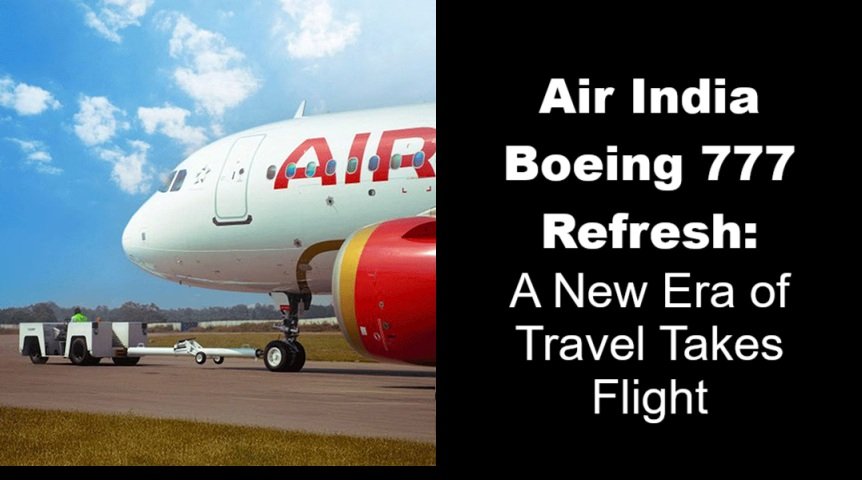
On April 3, 2025, Air India’s ambitious fleet modernization program reached a significant milestone with the return of its first legacy Boeing 777 from a comprehensive interior refresh in Singapore. This development has sparked widespread interest among aviation enthusiasts, travelers, and industry observers alike, as the airline seeks to redefine its image and elevate the passenger experience on its long-haul routes, particularly to the United States and Canada. While this initial refurbishment focuses on cosmetic upgrades rather than structural overhauls, it signals the beginning of a broader transformation for Air India’s wide-body fleet, with more extensive changes on the horizon.
The Refresh Unveiled: What’s New?
The first Boeing 777 to undergo this refresh, registered as VT-ALK, touched down in India on the evening of April 2, 2025, after a month-and-a-half-long process in Singapore. This aircraft, part of Air India’s legacy fleet, has been given a revitalized interior designed to offer passengers a fresh and modern feel. The updates include new seat covers, updated carpeting, and a general sprucing up of the cabin ambiance. These changes aim to bridge the gap between the airline’s current offerings and the premium experience it aspires to deliver as part of its ongoing rebranding efforts under the Tata Group, which reacquired Air India in 2021.
Unlike a full retrofit, this refresh does not yet include major upgrades such as new in-flight entertainment (IFE) systems or seat replacements. Industry chatter suggests that supply chain constraints have delayed more substantial modifications, leaving the “bones” of the aircraft—its core structural and mechanical components—unchanged for now. Nevertheless, the revamped upholstery and carpets are a noticeable step forward, offering a cleaner, more contemporary look that aligns with Air India’s goal of shedding its dated reputation.
The refreshed Boeing 777 is slated to resume service almost immediately, with a domestic flight to Chennai scheduled for April 3, followed by a return to international duties on April 4. This quick turnaround underscores Air India’s urgency to get its upgraded aircraft back into the skies, particularly on lucrative North American routes where competition is fierce.
A Fleet-Wide Transformation in Progress
This initial refresh is just the tip of the iceberg. Air India has announced plans to overhaul 12 more Boeing 777s in the coming weeks, with each aircraft expected to undergo a similar interior makeover. The timeline for the first aircraft—approximately six weeks—suggests a staggered but steady rollout, with the entire project likely spanning several months. Once completed, these 13 refreshed Boeing 777s will form a more cohesive and visually appealing fleet, better equipped to compete with global carriers like Emirates, Qatar Airways, and United Airlines on long-haul routes.
Looking beyond this interim refresh, Air India has hinted at more ambitious upgrades in the pipeline. Future phases are expected to include the installation of modern IFE systems, new seating configurations, and possibly enhanced cabin layouts to offer premium economy, business, and first-class options that rival the best in the industry. However, these plans hinge on overcoming supply chain bottlenecks, a challenge that has plagued the aviation sector since the pandemic disrupted global manufacturing and logistics.
Why Now? The Strategic Context
Air India’s focus on refreshing its Boeing 777 fleet comes at a pivotal moment. The airline has long been criticized for its aging aircraft and inconsistent service, issues that have hampered its ability to compete in the premium travel market. Since its return to Tata ownership, Air India has embarked on an aggressive revitalization strategy, which includes fleet expansion, route network growth, and a renewed emphasis on customer experience. The Boeing 777 refresh is a tangible manifestation of this vision, offering a quick win while longer-term projects—like the delivery of new Airbus A350s and Boeing 787s—take shape.
The choice of the Boeing 777 for this initial phase is strategic. As a workhorse of Air India’s long-haul operations, the 777 connects major Indian cities like Delhi and Mumbai to destinations such as New York, San Francisco, and Toronto. By prioritizing these aircraft, Air India aims to enhance its appeal to international travelers, particularly in the lucrative U.S. and Canadian markets, where passengers expect a higher standard of comfort and reliability.
Passenger Reactions and Industry Buzz
Early reactions to the refresh, as reflected in posts found on X, have been largely positive, with travelers and aviation buffs sharing excitement over the “zhakas” (slang for “fantastic” in Hindi) new look. Exclusive images circulating online showcase the updated cabin, highlighting the fresh seat covers and carpeting that give the aircraft a renewed lease on life. However, some observers have tempered their enthusiasm, noting that the absence of new seats or IFE systems limits the scope of this upgrade. For now, the refresh appears to be a stopgap measure—a way to buy time and improve perceptions while more transformative changes are prepared.
Aviation analysts see this as a pragmatic move by Air India. By focusing on visible, passenger-facing improvements, the airline can signal progress without the massive capital investment required for a full fleet overhaul. It’s a balancing act: maintaining operational continuity while gradually aligning the fleet with modern standards.
Challenges and What Lies Ahead
Despite the optimism, challenges remain. The six-week timeline for the first aircraft suggests that completing the refresh for all 13 Boeing 777s could stretch into late 2025 or early 2026, assuming no further delays. Supply chain issues, a recurring theme in the aviation industry, could also push back the more extensive upgrades Air India has promised. Additionally, the airline must ensure that its on-ground service—check-in, lounges, and in-flight crew performance—matches the improved cabin experience to deliver a truly cohesive brand promise.
Looking ahead, Air India’s success will depend on its ability to execute this multi-phase transformation without alienating its customer base. The refreshed Boeing 777s are a promising start, but they’re only one piece of a much larger puzzle. As the airline integrates new aircraft, refines its operations, and competes in an increasingly crowded market, the stakes are high. For now, though, the return of VT-ALK marks a symbolic moment—a sign that Air India is serious about reclaiming its place among the world’s leading carriers.
Conclusion
The Air India Boeing 777 refresh, trending on X as of April 3, 2025, is more than just a cosmetic facelift; it’s a statement of intent. While the updates are modest compared to the sweeping changes planned for the future, they offer passengers a glimpse of what’s to come: a revitalized Air India that blends its rich heritage with a forward-looking vision. As the remaining 12 aircraft undergo their makeovers and the airline prepares for the next phase of its evolution, all eyes will be on how this storied carrier navigates the skies—and the competition—in the months ahead. For travelers boarding the refreshed VT-ALK this week, the journey promises to be a little brighter, a little fresher, and a lot more hopeful.







